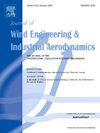An aerodynamic model for 6-DOF flight motion of windborne debris of square plates
IF 4.2
2区 工程技术
Q1 ENGINEERING, CIVIL
Journal of Wind Engineering and Industrial Aerodynamics
Pub Date : 2024-10-29
DOI:10.1016/j.jweia.2024.105929
引用次数: 0
Abstract
Plate-type debris is a typical type of windborne debris, often originating from roof tiles and shingles. Numerical simulation using aerodynamic models provides a practical method to predict trajectories of windborne debris. In this paper, we first propose a revised model for the 3-degree-of-freedom (3-DOF) flight motion of square plates in winds by integrating experimental data from previous studies. Thereby, we divide the aerodynamic force and moment into a translational part and a rotational part. In addition, we propose conditions of autorotation in the revised model. The calculation of the rotational force and moment depends on whether these conditions are fulfilled. The revised model is validated by comparing the numerical results with experimental results of plate trajectories. Next, based on the revised model for the 3-DOF motion, we propose an aerodynamic model for the 6-DOF motion by incorporating the findings about the rotational force and moment, which were obtained from the authors’ previous study on the 6-DOF motion of square plates. Based on these findings, the model is developed in the way that the direction of the rotational force depends on the relative wind velocity and the angular velocity of plate, and the direction of the rotational moment depends on the translational moment. By doing so the proposed model in this paper avoids directly using a database of aerodynamics, which is large and difficult to obtain. Validation using the experimental results of plate trajectories shows that the proposed model, which has a relatively simple form, performs generally well.
方板风载碎片 6-DOF 飞行运动空气动力学模型
板状碎片是一种典型的风载碎片,通常来自屋顶瓦片和木瓦。利用空气动力学模型进行数值模拟为预测风载碎片的轨迹提供了一种实用方法。在本文中,我们首先通过整合以往研究的实验数据,提出了方形板块在风中的三自由度(3-DOF)飞行运动修正模型。因此,我们将空气动力和力矩分为平移部分和旋转部分。此外,我们还在修订后的模型中提出了自动旋转的条件。旋转力和旋转力矩的计算取决于是否满足这些条件。通过将数值结果与板轨迹的实验结果进行比较,对修订后的模型进行了验证。接下来,根据修订后的 3-DOF 运动模型,我们提出了一个 6-DOF 运动的空气动力学模型,该模型结合了作者之前对方形板 6-DOF 运动的研究中获得的有关旋转力和力矩的结论。根据这些研究结果,模型的旋转力方向取决于相对风速和板的角速度,旋转力矩方向取决于平移力矩。这样,本文提出的模型就避免了直接使用空气动力学数据库,因为该数据库庞大且难以获得。利用平板轨迹的实验结果进行的验证表明,所提出的模型形式相对简单,总体性能良好。
本文章由计算机程序翻译,如有差异,请以英文原文为准。
求助全文
约1分钟内获得全文
求助全文
来源期刊
CiteScore
8.90
自引率
22.90%
发文量
306
审稿时长
4.4 months
期刊介绍:
The objective of the journal is to provide a means for the publication and interchange of information, on an international basis, on all those aspects of wind engineering that are included in the activities of the International Association for Wind Engineering http://www.iawe.org/. These are: social and economic impact of wind effects; wind characteristics and structure, local wind environments, wind loads and structural response, diffusion, pollutant dispersion and matter transport, wind effects on building heat loss and ventilation, wind effects on transport systems, aerodynamic aspects of wind energy generation, and codification of wind effects.
Papers on these subjects describing full-scale measurements, wind-tunnel simulation studies, computational or theoretical methods are published, as well as papers dealing with the development of techniques and apparatus for wind engineering experiments.

 求助内容:
求助内容: 应助结果提醒方式:
应助结果提醒方式:


